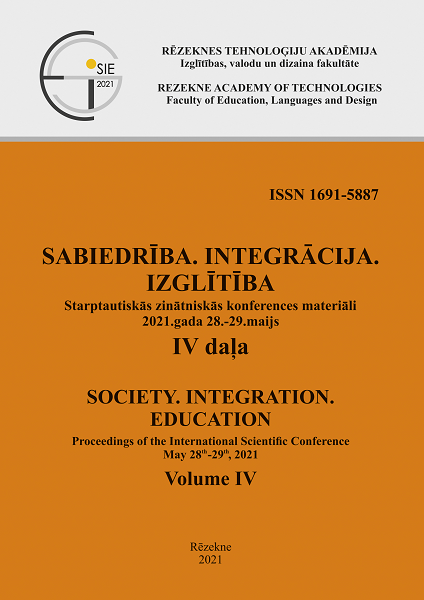THE DYNAMICS OF INDICATORS OF PSYCHO-EMOTIONAL CONDITION OF COLLEGE STUDENTS, INFLUENCED BY TEAMBUILDING TECHNOLOGIES
DOI:
https://doi.org/10.17770/sie2021vol4.6188Keywords:
physical education, psycho-emotional condition, students, team-building techniqueAbstract
Specialists say that the issue of understanding of influence mechanism of physical activity on psychological health of children and teenagers is not investigated thoroughly. This concerns primarilycollege students, fortheir age equals to that of high school pupils.Psycho-emotional processes in the students’ consciousness and behavior atthat ageare caused by the end of biological and physical development and adaptation to new conditions of studying and living. Our previous research allowed us to determine the condition and dynamics of psycho-emotional indicators during the first academic year against the background of low physical activity. The question of how particular physical activity influences the dynamics of these indicators among college students remains to be unanswered. The aim of the research is to determine the dynamics of indicators of psycho-emotional condition among 15–16 years old students from Medical College. Research methods and techniques like analysis and generalization of scientific literature, documentation, pedagogical observation, SAN and mathematical statistics were applied. The results of the research. Any reliable changes towards either more positive or negative side have not been detected among students from Experimental Group (EG), though indicators of well-being and mood of students from Control Group (CG) have considerably decreased (p≤0,05) during the pedagogical experiment. The reliable deterioration of the CG students’ well-beingfrom have been noticed in comparison with the EG students on the 2nd stage of the experiment. The conclusions. The data obtained from the pedagogical experiment have proved the positive effect of implementation of team-building techniques into physical education of college students on their psycho-emotional condition indicators.References
Antonov, O. V. (2013). Innovative technologies gaming orientation with the application of hiking for the development of psychomotor skills high school students. Series.: Pedagogical sciences. Physical education and sport,112(1), 17–25.
Bodnar, I. R., Vynogradskiy, B. A., Pavlova, Y. O., Ripak, M. O., Dukh, T. I., & Stephanyshyn, M. V. (2018). The evaluation of physical preparation and health of different society groups. Lviv. LSUPhC
Doskin, V. A., Lavrentieva, N. A., Miroshnikov, M. P., Sharai, V. B. (1973). The test of differentiated self-esteem of functional condition. The questions of psychology, 6, 141–145.
Gieroba, B. (2019). Effect of physical activity on mental health and cognitive functions. Medycyna Ogólna i Nauki o Zdrowiu, 25(3), 153–161. https://doi.org/10.26444/monz/112259
Khanikiants, O. (2011). The specific of organization and performing physical education classes woth students from special medical groups. Pedagogical sciencies: theory, history, innovative technologies, 8(18), 300–307.
Khoroshilove, D., & Hilger, E. (2019). Social & Behavioural Sciences PSYRGGU 2019 Psychology of subculture : Phenomenology and Contemporary Tendencies of Development SOCIAL BELIEFS PSYCHOLOGICAL WELL-BEING OF THE. PSYRGGU 2019 Psychology of Subculture: Phenomenology and Contemporary Tendencies of Development, 1–9.
Kondratets, I. (2019). Team-building: how to form a team from a group. Pre-school education, (11), 7–11. Retrieved from: https://dv.in.ua/2019-11/p7
Nikifirova, L. O., & Bilokon, Y. V. (2012) Team-building as a basis of the effective development of a group. Economic space, 59, 218–225. Retrieved from: http://ir.lib.vntu.edu.ua/handle/123456789/11942
Romanovskiy, O. G., Shapovalova, O. G., Kvasnyk, O. V., & Gura, T. V. (2017). The psychology of teambuilding: studying guide. Kharkiv: Madrid Publishing house. Retrieved from: http://repository.kpi.kharkov.ua/bitstream/KhPI-Press/36676/1/Book_2017_Romanovskyi_Psykholohiia_tymbildynhu.pdf
Rymar, O. & Solovei, A. (2015). The dynamics of valuable orientations in high school. Young sport science of Ukraine, 19(2), 221–225.
Semenova, N. (2015). Rationale mode motor activity of 15–17 years old female students with different levels of somatic health: (Master's thesis). Retrieved from: http://repository.ldufk.edu.ua/handle/34606048/273
Semenova, N., & Mahlovanyi, A. (2015). Motor activity and psycho-emotional condition of 15–17 years old female students. Physical Education, Sport and Health Culture in Modern Society, 2(30), 95–98. Retrieved from: https://sport.vnu.edu.ua/index.php/sport/article/view/202
Semenova, N., & Mahlovanyi, A. (2017). Emotional Condition and Physical Activity of First-year Female Students at Medical College During the Academic Year. Teorìâ Ta Metodika Fìzičnogo Vihovannâ, 17(2), 62–66. https://doi.org/10.17309/tmfv.2017.2.1190
Solovei, A., Rymar, O., Yaroshyk, M., & Sorokolit, N. (2017). The Current State and the Peculiarities of Physical Activity of Teenagers in Ukraine and Poland. Physical Education, Sports and Health Culture in Modern Society, 1(37), 91–96. https://doi.org/10.29038/2220-7481-2017-01-91-96
Yachniuk, M. Y. (2016). The technology of implementation of active tourism tools in the recreation activity of students’ youth. (Master'sthesis). Retrieved from: http://reposit.uni-sport.edu.ua/handle/787878787/651
Zavydivska, N., & Khanikiants, O. (2016). The reorganization system of the high school students’ physical education: problems and perspectives. Physical Education, Sport and Health Culture in Modern Society, 33, 51–56.
Zavydivska, O. I., Zavydivska, N. N., Khanikiants, O. V., & Rymar, O. V. (2017). The paradigm of health maintenance at higher education institutions as an important component of human development in terms of modernity. Journal of Physical Education and Sport, 17(1), 60–65.






